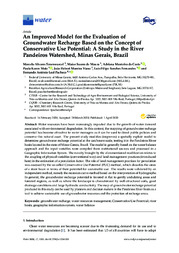An improved model for the evaluation of groundwater recharge based on the concept of conservative use potential: a study in the river Pandeiros Watershed, Minas Gerais, Brazil.
An improved model for the evaluation of groundwater recharge based on the concept of conservative use potential: a study in the river Pandeiros Watershed, Minas Gerais, Brazil.
Author(s): TENENWURCEL, M. A.; MOURA, M. S. de; COSTA, A. M. da; MOTA, P. K.; VIANA, J. H. M.; FERNANDES, L. F. S.; PACHECO, F. A. L.
Summary: Water resources have been increasingly impacted due to the growth of water demand associated with environmental degradation. In this context, the mapping of groundwater recharge potential has become attractive to water managers as it can be used to direct public policies and conserve this natural asset. The present study modi?es (improves) a spatially explicit model to determine groundwater recharge potential at the catchment scale, testing it in the Pandeiros River basin located in the state of Minas Gerais, Brazil. The model is generally based on the water balance approach and the input variables were compiled from institutional sources and processed in a Geographic Information System. The novelty brought by the aforementioned modi?cation relates to the coupling of physical variables (conventional way) and land management practices (introduced here) in the estimation of a percolation factor. The role of land management practices for percolation was assessed by the so-called Conservative Use Potential (PUC) method, which classi?es the areas of a river basin in terms of their potential for sustainable use. The results were validated by an independentmethod,namelytherecessioncurvemethodbasedontheinterpretationofhydrographs. In general, the groundwater recharge potential is favored in ?at to gently undulating areas and forested regions, as well as where the landscape is characterized by well-structured soils, good drainage conditions and large hydraulic conductivity. The map of groundwater recharge potential producedinthisstudycanbeusedbyplannersanddecisionmakersinthePandeirosRiverbasinasa tool to achieve sustainable use of groundwater resources and the protection of recharge areas.
Publication year: 2020
Types of publication: Journal article
Unit: Embrapa Maize & Sorghum
Observation
Some of Embrapa's publications are published as ePub files. To read them, use or download one of the following free software options to your computer or mobile device. Android: Google Play Books; IOS: iBooks; Windows and Linux: Calibre.
Access other publications
Access the Agricultural Research Database (BDPA) to consult Embrapa's full library collection and records.
Visit Embrapa Bookstore to purchase books and other publications sold by Embrapa.

